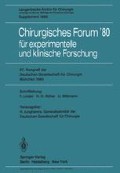Zusammenfassung
Das Hauptproblem aller portosystemischen Shunt-Operationen ist die Verminderung der Lebergesamtdurchblutung. Eine portale Restperfusion nach portocavalem Seit-zu-Seit-, nach mesocavalem oder lateral-splenorenalem Shunt wird immer häufiger in Frage gestellt, bzw. verneint: Dies wäre bei weiterbestehendem Druckgefälle und offener Anastomose auch nicht vorstellbar, physikalisch sogar widersprüchlich (2). Die portocavale End-zu-Seit-Anastomose bringt unter allen Shuntformen die beste portale Drucksenkung. Entsprechend früherer Autoren (1, 4) erscheint es sinnvoll, den Pfortaderstumpf zu „arterialisieren“. Logische Voraussetzung jedoch ist, daß der Flow in der arterialisierten Pfortader nicht ansteigt. Bei gleichbleibendem Leberwiderstand stellt sich dann auch der Druck im Pfortaderstumpf zwangsläufig auf den vorbestehenden Wert ein. Bisherige Tierexperimente erbrachten widersprüchliche Ergebnisse, insbesondere über die erste po Woche hinaus (1, 3, 4, 5). Ziel dieser Untersuchungen soll es sein, wie sich unter der scharfen Voraussetzung der Flowlimitierung mehrere „Leberparameter“ bis zum 21. po Tag bei lebergesunden und experimentell cirrhotischen Ratten verändern.
Access this chapter
Tax calculation will be finalised at checkout
Purchases are for personal use only
Preview
Unable to display preview. Download preview PDF.
Literatur
Adamsons, R.J., Arif, S., Babich, A., Butt, K., Lam, A., Minkowitz, St.: Arterialization of the liver in combination with portacaval shunt in the dog. Surgery, Gynecology & Obst. 140, 594–600 (1975)
Fulenwider, T.J., Nordlinger, B.M., Milikan, W.J., Sones, P.J., Warren, W.D.: Portal pseudoperfusion. Ann. Surg. 189, 257–268 (1979)
Lecompte, Y., Franco, D., Martin, E.D., Bismuth, H.: Liver arterialization with portacaval shunt in the cirrhotic rat. Surgery 75, 161–168 (1974)
Matzander, U.: Methode und Technik der druckadaptierten Leberarterialisation mit portocavaler Anastomose. Chirurg 45, 226–231 (1974)
McCredie, J.A., Doggart, J.R., Welbourn, R.B.: Total arterialization of the liver. Br. J. of Surgery 45, 83–100 (1958)
Author information
Authors and Affiliations
Editor information
Editors and Affiliations
Rights and permissions
Copyright information
© 1980 Springer-Verlag Berlin · Heidelberg
About this paper
Cite this paper
Hirner, A., Häring, R., Karavias, T. (1980). Verhindert die Flow-limitierte Pfortader-Arterialisation die Nachteile des portocavalen Shunts bei der gesunden und cirrhotischen Ratte?. In: Linder, F., Röher, HD., Mittmann, U., Junghanns, H. (eds) Chirurgisches Forum’80. Langenbecks Archiv für Chirurgie, vol 80. Springer, Berlin, Heidelberg. https://doi.org/10.1007/978-3-642-67617-8_31
Download citation
DOI: https://doi.org/10.1007/978-3-642-67617-8_31
Publisher Name: Springer, Berlin, Heidelberg
Print ISBN: 978-3-540-10035-5
Online ISBN: 978-3-642-67617-8
eBook Packages: Springer Book Archive

